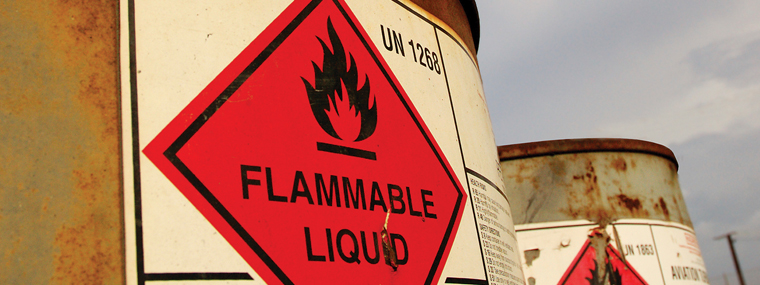
Safety: Safety Series, Part 13:
Chemical Hazards at Work: What You Don’t Know CAN Hurt You!
By Terri Perrin / Published June 2016

Power washing and waterjetting technicians work with water at high temperatures and high psi. Directing spray from the wand toward people or animals can have deadly consequences, but the potential damage from a water blast isn’t the only risk. Coming into contact with hazardous chemicals is another everyday hazard that must be taken very seriously. When it comes to the safe use, storage, and disposal of chemicals and the containers they come in, ignorance is not bliss—it’s dangerous!
Not being properly trained, the absence of workplace safety procedures, and lack of personal protective equipment (PPE) can result in workers being exposed to substances that may cause significant acute or long term injury to the eyes, skin, or respiratory system. The use of chemicals in the cleaning process can result in ‘splash back’ of caustic compounds, either from the cleaning solution itself or the surface being cleaned, as well as the unintended release of toxic or flammable fluids or gasses, and a myriad of other accidental exposures.
Chemical Use Then and Now
In a career that spans more than 40 years, Terry Murray has seen a dramatic shift in how chemicals are formulated, packaged, labeled, and transported. He started as a chemical sales rep with Quaker State in the early 1970s. When the company made the decision to disband the retail section of the business in 1980, Murray and his colleague, Mike Turner, decided to buy it. They named their new enterprise Etowah Chemical, after the county where they are located. The company, headquartered in Birmingham, AL, has grown to more than 80 employees in six locations. Murray is the vice president and is also a past president of the Cleaning Equipment Trade Association (CETA).
“Over the years, we have moved from using highly caustic products to ones that have a lower phosphorus and cleaning surface active agents [surfactants] content,” explains Murray. “We have far better labeling systems, with internationally-recognized warning symbols. Safety Data Sheets (SDS) provide information on how to handle the products and emergency first-aid measures in the event of accidental exposure.
“Today’s cleaning products are not only safer for the people who use them and easier on the equipment but also better for the environment,” he adds. “Industry, in general, has also made great strides in the manufacturing of better personal protective equipment and education of the worker, as well as wastewater collection and disposal. I am very proud of what the power washing industry has accomplished.”
Be Safe, Not Sorry
To ensure that the people who use their products understand the risks, many chemical manufacturers offer comprehensive, on-site training. Etowah Chemical even has a full-time chemist on staff to ensure products are safe and that the sales representatives are well versed on the safe use, transport, and storage of their products. If training is not available in your region, ask your product representative what training resources they can provide.
There is also a wealth of resources online, in the form of YouTube videos, articles, and more. Safety training and education specifically related to chemical use is easy to find online, and the cost for the training and certification of workers is not expensive.
You are also well advised to be certain that you are knowledgeable on regulations in any areas where you do business. Municipalities continue to tighten regulations relating to chemical use, and accepted standards may vary widely from one city to the next.
The Importance of Safety Data Sheets
The label on any chemical can only display a limited amount of text. Safety Data Sheets (SDS) were developed to provide more detailed information. SDSs are an essential starting point for the development of a complete health and safety program for your business. Every workplace and vehicle should have a binder containing SDSs for every chemical used. Workers should know where the binders are kept and be educated about the vital information they contain.
SDSs are written by the supplier and/or manufacturer and must contain the following information:
• The potential hazards (such as health, fire, reactivity, and environmental)
• How to work safely with the chemical product
• Proper storage and handling
• What to expect if the recomendations are not followed
• Emergency procedures if accidents or incidents occur
• How to recognize symptoms of overexposure (skin, respiratory, eyes).
Three Hazardous Chemical Labeling Systems Explained
INTERNATIONAL: Globally Harmonized System of Classification and Labeling (GHS)
http://goo.gl/XuJCgc
In 2003, the United Nations (UN) adopted the Globally Harmonized System of Classification and Labeling of Chemicals (GHS). The GHS includes criteria for the classification of health, physical, and environmental hazards, as well as specifying what information should be included on labels of hazardous chemicals and safety data sheets.
The GHS provides an international approach to chemical hazard communication with agreed criteria for the classification of chemical hazards and a standardized approach to label elements and safety data sheets. It was negotiated over several years by hazard communication experts from many different countries, international organizations, and stakeholder groups. Major existing systems around the world, including OSHA’s Hazard Communication Standard and the chemical and labeling systems of other U.S. agencies, were used as the basis for the GHS. The result of this negotiation process is the United Nations’ document entitled “Globally Harmonized System of Classification and Labeling of Chemicals,” commonly referred to as The Purple Book. This document provides harmonized classification criteria for health, physical, and environmental hazards of chemicals. It also includes standardized label elements that are assigned to these hazard classes and categories, and provides the appropriate signal words, pictograms, and hazard and precautionary statements to convey the hazards to users. A standardized order of information for safety data sheets is also provided. These recommendations can be used by regulatory authorities such as OSHA to establish mandatory requirements for hazard communication but do not constitute a model regulation.
Adoption of the GHS in the U.S. and around the world will help to improve information received from other countries—since the U.S. is both a major importer and exporter of chemicals, American workers often see labels and safety data sheets from other countries. The diverse and sometimes conflicting national and international requirements can create confusion among those who seek to use hazard information effectively. For example, labels and SDSs may include symbols and hazard statements that are unfamiliar to readers or not well understood. Containers may be labeled with such a large volume of information that important statements are not easily recognized. Given the differences in hazard classification criteria, labels may also be incorrect when used in other countries. If countries around the world adopt the GHS, these problems will be minimized; and chemicals crossing borders will have consistent information, thus improving communication globally.
U.S.: OSHA’s Hazard Communication Standard (HCS)
www.osha.gov/dsg/hazcom
Since it was first established in 1983, OSHA’s Hazard Communication Standard (HCS) has provided employers and employees with extensive information about the chemicals in their workplaces. The original standard is performance-oriented, allowing chemical manufacturers and importers to convey information on labels and material SDSs in whatever format they choose. While the available information has been helpful in improving employee safety and health, a more standardized approach to classifying the hazards and conveying the information will be more effective and provide further improvements in American workplaces.
OSHA has modified the Hazard Communication Standard (HCS) to adopt the GHS to improve safety and health of workers through more effective communications on chemical hazards. This will enhance both employer and worker comprehension of the hazards, which will help to ensure appropriate handling and safe use of workplace chemicals. The SDS requirements also establish a consistent order of information. The harmonized format of the SDSs will enable employers, workers, health professionals, and emergency responders to access the information more efficiently and effectively, thus increasing their utility.
CANADA: Workplace Hazards Materials Information System (WHMIS)
http://goo.gl/sgdjDt
On February 11, 2015, the Government of Canada modified the Workplace Hazardous Materials Information System (WHMIS) 1988. The revised standards incorporate the GHS for workplace chemicals. This modified WHMIS is referred to as ‘WHMIS 2015.’ The Controlled Products Regulations (CPR) and the Ingredient Disclosure List (IDL) have been repealed. There is a transition period to allow Canadian suppliers, employers, and workers time to adjust and comply with WHMIS 2015.
Be aware that a label or SDS that is compliant with the OSHA Hazard Communication Standard (2012) may not be sufficient for compliance in Canada. Companies that ship chemicals to Canadian markets are advised to review WHMIS 2015 to ensure compliance.





